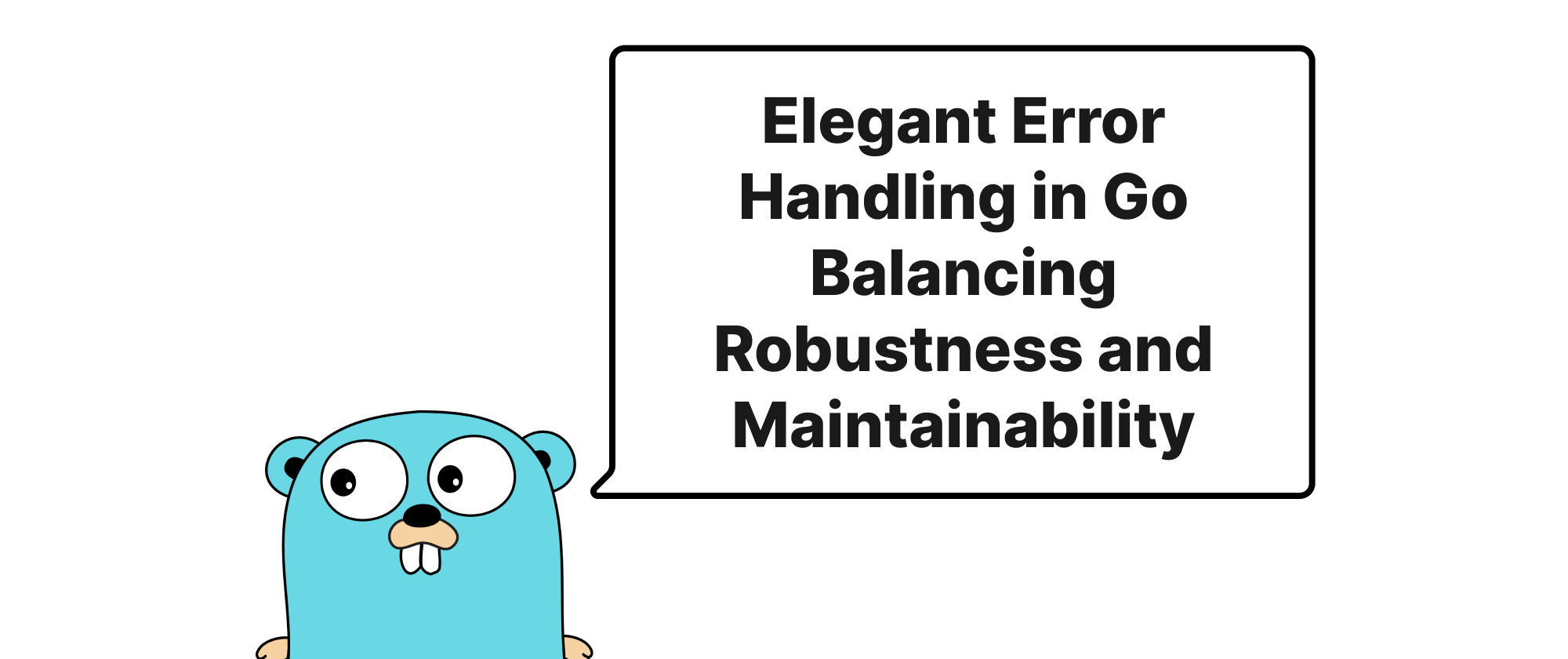Elegant Error Handling in Go Balancing Robustness and Maintainability
Ethan Miller
Product Engineer · Leapcell

Introduction
In the intricate world of software development, errors are inevitable. They are the unwelcome guests that can corrupt data, crash applications, or simply lead to a frustrating user experience. How a language empowers developers to anticipate, detect, and gracefully recover from these anomalies is a cornerstone of its design philosophy. Go, renowned for its simplicity, concurrency, and performance, offers a distinct approach to error management, primarily through its error type and the panic/recover mechanism. Understanding the nuances of these two seemingly disparate methods – when to use error and when panic – is crucial for building robust, maintainable, and idiomatic Go applications. This article delves into Go's error handling philosophy, comparing error and panic, and provides practical strategies for crafting an elegant and effective error management system.
The Go Error Handling Philosophy: Error vs. Panic
Go's approach to errors is deeply rooted in transparency and explicit handling. Unlike many languages that heavily rely on exceptions for most error conditions, Go encourages developers to treat errors as regular return values. This design choice forces developers to acknowledge and handle potential issues at the call site, promoting a clear and predictable flow of control.
The error Type: Explicit and Expected Problems
At the heart of Go's explicit error handling is the built-in error interface:
type error interface { Error() string }
Any type that implements the Error() string method can be considered an error. Most commonly, errors are created using errors.New() for simple string messages or fmt.Errorf() for formatted messages and wrapping other errors.
Principle: The error type is designed for expected, recoverable problems that are part of the normal program flow. These are conditions that you anticipate might happen and for which you have a clear recovery strategy.
Example:
Consider a function that reads a configuration file. The file might not exist, or it might be malformed. These are expected scenarios that the function should communicate to its caller.
package main import ( "errors" "fmt" "os" ) // ErrConfigNotFound is an example of a custom error. var ErrConfigNotFound = errors.New("configuration file not found") // readConfig simulates reading a configuration file. // It returns the config data (a string for simplicity) and an error. func readConfig(filename string) (string, error) { data, err := os.ReadFile(filename) if err != nil { if os.IsNotExist(err) { return "", fmt.Errorf("%w: %s", ErrConfigNotFound, filename) } // Wrap other file system errors return "", fmt.Errorf("failed to read config file %s: %w", filename, err) } // Simulate parsing the config, which might also fail if len(data) == 0 { return "", errors.New("config file is empty") } return string(data), nil } func main() { config, err := readConfig("non_existent_config.toml") if err != nil { fmt.Printf("Error reading config: %v\n", err) if errors.Is(err, ErrConfigNotFound) { fmt.Println("Suggestion: Create the configuration file.") } return } fmt.Printf("Config data: %s\n", config) config, err = readConfig("empty_config.txt") // Assume this file exists but is empty if err != nil { fmt.Printf("Error reading config: %v\n", err) // No specific 'Is' check needed here for empty, it's just a generic error return } fmt.Printf("Config data: %s\n", config) }
In this example, the readConfig function returns an error if the file cannot be read, is not found, or is empty. The main function explicitly checks err and handles different error conditions, demonstrating the power of errors.Is for checking specific error types and errors.As (not shown, but useful for extracting specific error structs) for unpacking errors. The use of fmt.Errorf("%w", err) allows for error wrapping, preserving the original error context and enabling more precise error inspection.
panic and recover: Exceptional and Unrecoverable Problems
While error handles expected problems, panic and ``recover` are Go's mechanisms for dealing with exceptional, unrecoverable situations – problems that indicate a bug in the program or a severe, unexpected failure.
Principle:
panic: Used when a program encounters a condition that it cannot possibly continue from, often indicating a programmer error or a state that should never be reached. It unwinds the stack, executing deferred functions as it goes.recover: Used within adeferfunction to regain control of a panicking goroutine. It's typically used to clean up resources, log the panic, and potentially allow the program to continue in a degraded but safe state (though this is rare for general applications, more common for things like web servers to keep serving other requests).
Example:
A common use case for panic is when an unrecoverable argument is passed to a function, or a package initialization fails critically.
package main import ( "fmt" ) // divide performs division. Panics if denominator is zero. // This is typically NOT how you'd handle division by zero in Go. // It's used here purely for demonstration of panic. func divide(numerator, denominator int) int { if denominator == 0 { panic("division by zero is undefined") // A severe, unrecoverable error for this function } return numerator / denominator } func main() { fmt.Println("Starting program.") // Example 1: No panic occurs result1 := divide(10, 2) fmt.Printf("10 / 2 = %d\n", result1) // Example 2: Panic occurs, deferred function catches it func() { // Anonymous function to encapsulate the defer and recover for this attempt defer func() { if r := recover(); r != nil { fmt.Printf("Recovered from panic: %v\n", r) } }() fmt.Println("Attempting division by zero...") result2 := divide(10, 0) // This will panic fmt.Printf("10 / 0 = %d\n", result2) // This line will not be reached }() // Execute the anonymous function immediately fmt.Println("Program continues after attempted division by zero (due to recover).") // Example 3: Panic without recover (will terminate the program) // Uncomment the following block to see program termination /* fmt.Println("Attempting another division by zero without recover...") result3 := divide(5, 0) // This will panic and exit the program fmt.Printf("5 / 0 = %d\n", result3) */ fmt.Println("Program finished.") }
In main, the first divide call succeeds. The second call is wrapped in a func(){ ... }() block with a defer that includes recover. When divide(10, 0) panics, the execution unwinds to the deferred function, recover captures the panic value, and the program continues. If recover were not present, or if the panic happened outside such a defer/recover block in the main goroutine, the entire program would terminate.
Important Note: The Go standard library uses panic in very specific, limited scenarios, such as json.Unmarshal when unmarshaling into a non-pointer, or template.Must to signal a fatal configuration error during template parsing. Generally, for typical application logic, panic is reserved for truly unrecoverable conditions or programmer errors. Most applications use error for the vast majority of error reporting.
Designing Elegant Error Handling Strategies
The key to elegant error handling in Go lies in a clear distinction between these two mechanisms and a consistent application of principles:
-
Prefer
errorfor Expected Problems: This is the golden rule. If a condition can reasonably occur during normal operation (e.g., file not found, network timeout, invalid user input, database constraint violation), return anerror. This forces callers to acknowledge and handle the error, leading to more robust code. -
Use
panicfor Truly Exceptional/Unrecoverable Problems: Reservepanicfor situations where the program cannot continue in a meaningful way, often indicating:- Programmer Errors: e.g., passing
nilto a function that explicitly requires a non-nilargument for its core logic, or an invalid state being reached that "should never happen." - Unrecoverable Initialization Failures: If a critical part of your application fails to initialize (e.g., cannot connect to the primary database on startup) and there's no way to proceed,
panicmight be appropriate, especially ininit()functions (though oftenlog.Fatalfis preferred for explicit exit).
- Programmer Errors: e.g., passing
-
Return Errors Early: Go's multi-value returns make it natural to return an error as the last return value. When an error occurs, return it immediately to avoid unnecessary computation and simplify logic.
// Bad func doSomething(param string) (string, error) { if param == "" { return "", errors.New("param cannot be empty") } // ... complex logic ... return result, nil } // Good func doSomething(param string) (string, error) { if param == "" { return "", errors.New("param cannot be empty") } // ... complex logic ... return result, nil } -
Error Wrapping for Context: Use
fmt.Errorf("%w", err)to wrap errors. This allows you to add context to an error as it propagates up the call stack while retaining the original error, which can be inspected usingerrors.Isanderrors.As.// layered architecture example func getUserFromDB(id int) (*User, error) { // Simulates DB query error return nil, errors.New("database connection failed") } // Service layer func GetUserByID(id int) (*User, error) { user, err := getUserFromDB(id) if err != nil { return nil, fmt.Errorf("failed to retrieve user %d from database: %w", id, err) } return user, nil } -
Define Custom Error Types (When Necessary): For specific, programmatically significant error conditions, define custom error types (structs implementing
error). This allows for more precise checking and handling usingerrors.Asor type assertions.type InvalidInputError struct { Field string Value string Reason string } func (e *InvalidInputError) Error() string { return fmt.Sprintf("invalid input for field '%s': %s (value: '%s')", e.Field, e.Reason, e.Value) } func processRequest(data map[string]string) error { if data["name"] == "" { return &InvalidInputError{Field: "name", Value: "", Reason: "cannot be empty"} } // ... return nil } func main() { err := processRequest(map[string]string{}) if err != nil { var inputErr *InvalidInputError if errors.As(err, &inputErr) { fmt.Printf("Validation error on field %s: %s\n", inputErr.Field, inputErr.Reason) } else { fmt.Printf("Generic error: %v\n", err) } } } -
Handle Errors Where They Occur or Propagate: Don't ignore errors. Decide whether to handle an error at the current level (e.g., retry, log and continue, return a default value) or propagate it up the call stack to a level that can handle it. If unsure, propagate.
Conclusion
Go's error handling philosophy, centered on the error type for expected problems and the panic/recover mechanism for truly exceptional ones, demands explicit and thoughtful attention from developers. By consistently distinguishing between these two paradigms – returning error for anticipated issues and reserving panic for critical, unrecoverable failures – and by embracing principles like early returns, error wrapping, and custom error types, you can design and implement robust, maintainable, and elegantly Go-idiomatic error management strategies. This approach fosters code clarity, enhances predictability, and ultimately leads to more resilient applications.


